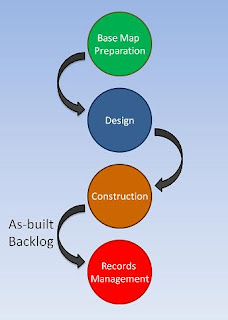The as-built backlog refers to the delay experienced between when infrastructure has been constructed and when information about this construction is entered into the records database. These delays often span months and sometimes years and make it difficult to provide reliable information about the infrastructure for field, management and regulatory requirements such as PSAB 3150.
 The as-built workflow can be explained with an example. A new subdivision project typically starts by assembling a collection of cadastral maps, existing infrastructure data and other information from a variety of sources to create a base map. Subdivision design is next; new infrastructure is drafted, existing infrastructure is updated and detailed design drawings for construction are created. Then construction takes place and upon completion, information about the construction is collected and compared to the design documents to create an as-built drawing. This as-built information is then used to update the infrastructure inventory database.
The as-built workflow can be explained with an example. A new subdivision project typically starts by assembling a collection of cadastral maps, existing infrastructure data and other information from a variety of sources to create a base map. Subdivision design is next; new infrastructure is drafted, existing infrastructure is updated and detailed design drawings for construction are created. Then construction takes place and upon completion, information about the construction is collected and compared to the design documents to create an as-built drawing. This as-built information is then used to update the infrastructure inventory database.The as-built problem arises for several reasons:
- Accelerated development during booming economies often means that engineering and construction firms have all-hands-on-deck to keep up with construction demand. Consequently, creating as-built drawings is sometimes just not a priority.
- As-built drawings are often created from paper design documents that contain redline markups describing the as-constructed information. These paper documents are then re-drafted to create an electronic version that is added to the infrastructure inventory database. The re-drafting effort is error prone and time consuming.
- As-built drawings and the infrastructure inventory database are often maintained via different systems (typically CAD and GIS) and by different departments. Loading CAD data into a records database may require translation, editing for topology and other inefficient workflows.
The solution requires a new way of thinking. Stay tuned as I discuss proposed solutions to the as-built problem in future posts.
Until next time…





1 comment:
Post a Comment